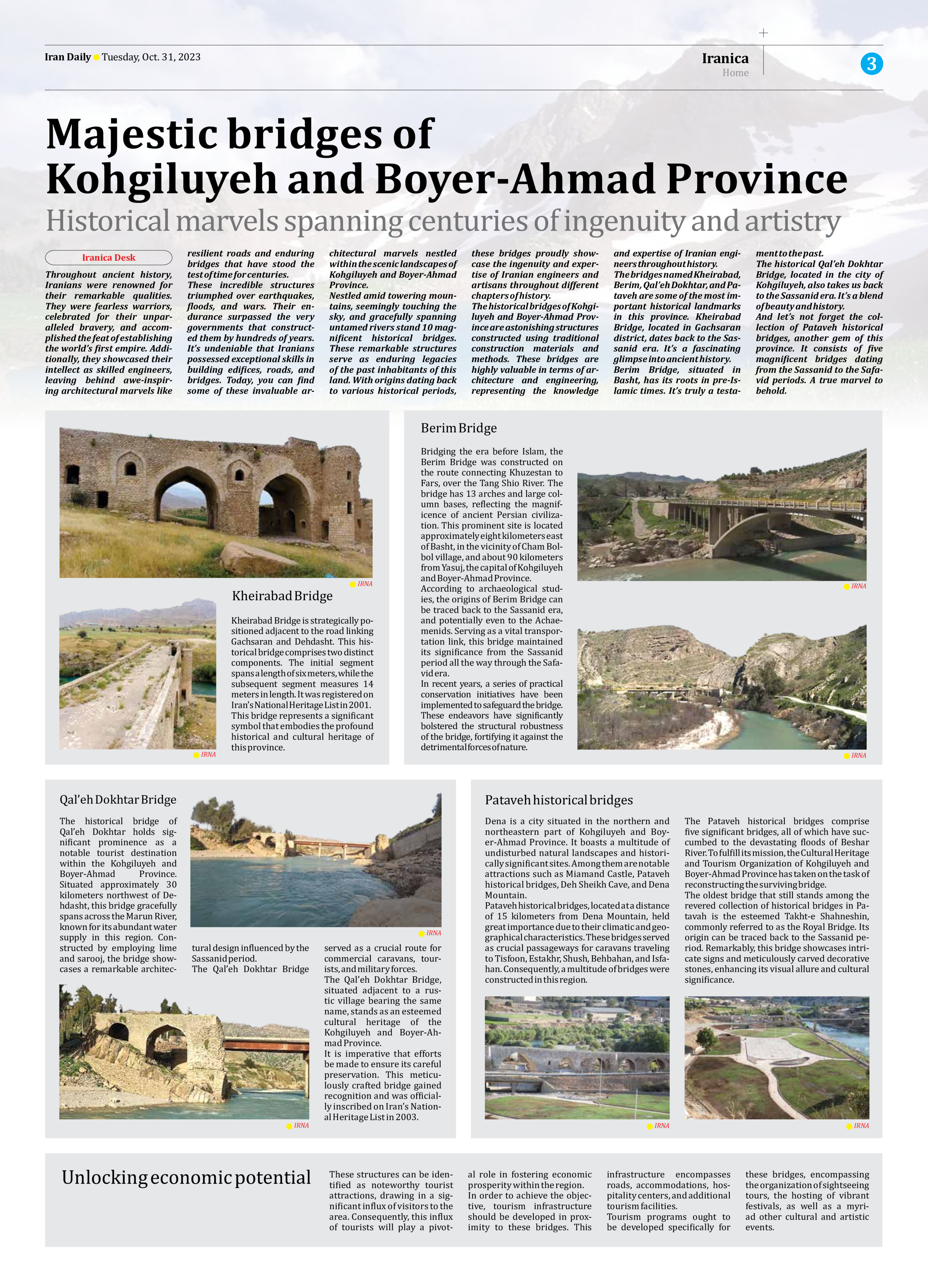
Majestic bridges of Kohgiluyeh and Boyer-Ahmad Province
Historical marvels spanning centuries of ingenuity and artistry
Throughout ancient history, Iranians were renowned for their remarkable qualities. They were fearless warriors, celebrated for their unparalleled bravery, and accomplished the feat of establishing the world’s first empire. Additionally, they showcased their intellect as skilled engineers, leaving behind awe-inspiring architectural marvels like resilient roads and enduring bridges that have stood the test of time for centuries.
These incredible structures triumphed over earthquakes, floods, and wars. Their endurance surpassed the very governments that constructed them by hundreds of years. It’s undeniable that Iranians possessed exceptional skills in building edifices, roads, and bridges. Today, you can find some of these invaluable architectural marvels nestled within the scenic landscapes of Kohgiluyeh and Boyer-Ahmad Province.
Nestled amid towering mountains, seemingly touching the sky, and gracefully spanning untamed rivers stand 10 magnificent historical bridges. These remarkable structures serve as enduring legacies of the past inhabitants of this land. With origins dating back to various historical periods, these bridges proudly showcase the ingenuity and expertise of Iranian engineers and artisans throughout different chapters of history.
The historical bridges of Kohgiluyeh and Boyer-Ahmad Province are astonishing structures constructed using traditional construction materials and methods. These bridges are highly valuable in terms of architecture and engineering, representing the knowledge and expertise of Iranian engineers throughout history.
The bridges named Kheirabad, Berim, Qal’eh Dokhtar, and Pataveh are some of the most important historical landmarks in this province. Kheirabad Bridge, located in Gachsaran district, dates back to the Sassanid era. It’s a fascinating glimpse into ancient history.
Berim Bridge, situated in Basht, has its roots in pre-Islamic times. It’s truly a testament to the past.
The historical Qal’eh Dokhtar Bridge, located in the city of Kohgiluyeh, also takes us back to the Sassanid era. It’s a blend of beauty and history.
And let’s not forget the collection of Pataveh historical bridges, another gem of this province. It consists of five magnificent bridges dating from the Sassanid to the Safavid periods. A true marvel to behold.
Kheirabad Bridge
Kheirabad Bridge is strategically positioned adjacent to the road linking Gachsaran and Dehdasht. This historical bridge comprises two distinct components. The initial segment spans a length of six meters, while the subsequent segment measures 14 meters in length. It was registered on Iran’s National Heritage List in 2001.
This bridge represents a significant symbol that embodies the profound historical and cultural heritage of this province.
Berim Bridge
Bridging the era before Islam, the Berim Bridge was constructed on the route connecting Khuzestan to Fars, over the Tang Shio River. The bridge has 13 arches and large column bases, reflecting the magnificence of ancient Persian civilization. This prominent site is located approximately eight kilometers east of Basht, in the vicinity of Cham Bolbol village, and about 90 kilometers from Yasuj, the capital of Kohgiluyeh and Boyer-Ahmad Province.
According to archaeological studies, the origins of Berim Bridge can be traced back to the Sassanid era, and potentially even to the Achaemenids. Serving as a vital transportation link, this bridge maintained its significance from the Sassanid period all the way through the Safavid era.
In recent years, a series of practical conservation initiatives have been implemented to safeguard the bridge. These endeavors have significantly bolstered the structural robustness of the bridge, fortifying it against the detrimental forces of nature.
Qal’eh Dokhtar Bridge
The historical bridge of Qal’eh Dokhtar holds significant prominence as a notable tourist destination within the Kohgiluyeh and Boyer-Ahmad Province. Situated approximately 30 kilometers northwest of Dehdasht, this bridge gracefully spans across the Marun River, known for its abundant water supply in this region. Constructed by employing lime and sarooj, the bridge showcases a remarkable architectural design influenced by the Sassanid period.
The Qal’eh Dokhtar Bridge served as a crucial route for commercial caravans, tourists, and military forces.
The Qal’eh Dokhtar Bridge, situated adjacent to a rustic village bearing the same name, stands as an esteemed cultural heritage of the Kohgiluyeh and Boyer-Ahmad Province.
It is imperative that efforts be made to ensure its careful preservation. This meticulously crafted bridge gained recognition and was officially inscribed on Iran’s National Heritage List in 2003.
Pataveh historical bridges
Dena is a city situated in the northern and northeastern part of Kohgiluyeh and Boyer-Ahmad Province. It boasts a multitude of undisturbed natural landscapes and historically significant sites. Among them are notable attractions such as Miamand Castle, Pataveh historical bridges, Deh Sheikh Cave, and Dena Mountain.
Pataveh historical bridges, located at a distance of 15 kilometers from Dena Mountain, held great importance due to their climatic and geographical characteristics. These bridges served as crucial passageways for caravans traveling to Tisfoon, Estakhr, Shush, Behbahan, and Isfahan. Consequently, a multitude of bridges were constructed in this region.
The Pataveh historical bridges comprise five significant bridges, all of which have succumbed to the devastating floods of Beshar River. To fulfill its mission, the Cultural Heritage and Tourism Organization of Kohgiluyeh and Boyer-Ahmad Province has taken on the task of reconstructing the surviving bridge.
The oldest bridge that still stands among the revered collection of historical bridges in Patavah is the esteemed Takht-e Shahneshin, commonly referred to as the Royal Bridge. Its origin can be traced back to the Sassanid period. Remarkably, this bridge showcases intricate signs and meticulously carved decorative stones, enhancing its visual allure and cultural significance.
Unlocking economic potential
These structures can be identified as noteworthy tourist attractions, drawing in a significant influx of visitors to the area. Consequently, this influx of tourists will play a pivotal role in fostering economic prosperity within the region.
In order to achieve the objective, tourism infrastructure should be developed in proximity to these bridges. This infrastructure encompasses roads, accommodations, hospitality centers, and additional tourism facilities.
Tourism programs ought to be developed specifically for these bridges, encompassing the organization of sightseeing tours, the hosting of vibrant festivals, as well as a myriad other cultural and artistic events.







